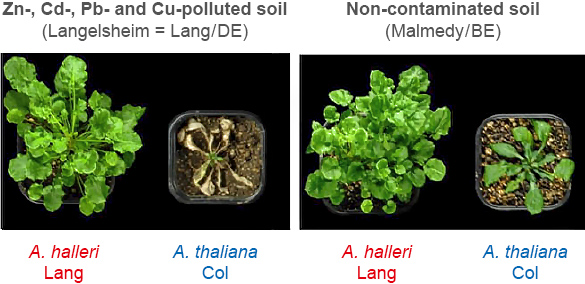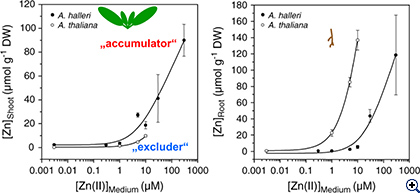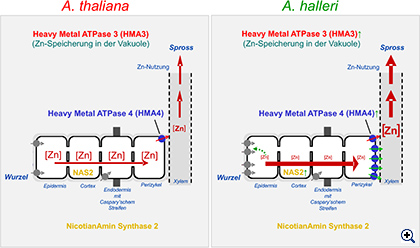Comparative Genomics
Comparative molecular analysis of metal homeostasis in the Arabidopsis model species A. halleri, a metal hyperaccumulator, and A. thaliana

Figure 1: Arabidopsis halleri can grow on a soil contaminated with toxic levels of heavy metals (left), but A. thaliana plants die when transplanted on this soil.
Figure 2: Arabidopsis halleri is a zinc hyperaccumulator: It accumulates higher zinc concentrations in shoots than A. thaliana and other non-hyperaccumulators, and lower zinc concentrations in roots, at a given zinc concentration in a hydroponic nutrient solution.
Summary
This project aims to expand our understanding of the molecular mechanisms underlying naturally selected, extreme, complex traits in plants. As model traits, zinc and cadmium hyperaccumulation and associated zinc- and cadmium-hypertolerance in Arabidopsis halleri are examined through the comparison with closely related non-tolerant non-accumulator species, primarily A. thaliana.
To examine the functions of candidate genes, for example AhHMA3 (Heavy Metal ATPase3), AhMTP1 (Metal Tolerance Protein1) and AhFRD3 (Ferric Reductase Defective3), two approaches are combined. Firstly, candidate genes are silenced through the stable transformation of A. halleri with RNA interference constructs. Secondly, candidate genes are introduced into A. thaliana. As several genes are likely to make significant contributions to metal hyperaccumulation and hypertolerance, respectively, transgenic A. thaliana lines will also be crossed to combine the functions of different candidate genes.
Besides gene copy number expansions, increases in expression levels of a number of candidate genes rather than changes in the functions of the encoded proteins appear to be characteristic of metal hyperaccumulators in comparison to closely related non-accumulators. High expression levels of AhHMA4 (Heavy Metal ATPase4) genes are specified in cis. Through promoter analysis we delineate the promoter regions and identify the cis-regulatory sequences governing high expression of AhHMA4 genes, and we aim to identify the transcription factors recruited by these sequence elements. To identify the types of mutations responsible for the high expression of additional candidate genes in A. halleri, promoter swap experiments between A. halleri and A. thaliana are also conducted.
Figure 3: Working model of the mechanism of Zn hyperaccumulation. Shown are processes in roots, which govern root-to-shoot Zn translocation. High expression levels of HMA4 have a key role.











